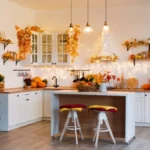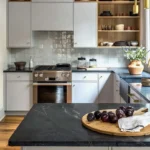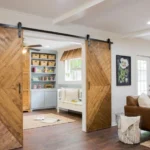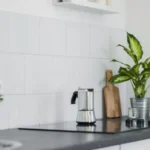A pony wall is a short wall, typically around three to four feet high, used in home design to divide spaces without obstructing light or airflow. Pony walls offer a stylish solution for creating separation in open-plan rooms while maintaining a sense of openness. Whether you’re looking for pony wall design ideas for your kitchen or exploring how to install one, this guide covers everything you need to know.

Content
What is a Pony Wall?
A pony wall is a partition that doesn’t extend all the way to the ceiling. Unlike full-height walls, pony walls are designed to divide spaces without closing off the room. They are commonly used in areas like kitchens, bathrooms, and hallways to create functional divisions while maintaining an open, airy feel. These walls are often seen in modern and minimalist home designs, adding both style and practicality.
In essence, pony walls serve as a perfect solution when you want to create separate zones in an open floor plan without fully enclosing the space. This is particularly useful in areas where light and airflow need to be preserved, such as living rooms or kitchens.
Why Choose a Pony Wall?
Choosing a pony wall for your home offers several benefits. First, they allow for the division of spaces while still maintaining a visual connection between areas. This is ideal for creating open-plan living spaces that feel spacious and airy. Additionally, pony walls can provide structural support for various design elements, such as countertops in kitchens or shelving units in bathrooms.

Another key advantage is their versatility. Pony walls can be customized to suit a wide variety of design styles, from sleek modern aesthetics to rustic, traditional looks. Whether you’re seeking to separate a dining area from the kitchen or need a privacy wall for a bathroom, pony walls offer endless possibilities for enhancing your space.
Pony Wall Design Ideas
When considering pony wall design ideas, it’s important to keep in mind the overall style of your home. For example, if you have a modern or minimalist interior, opting for a simple pony wall made of smooth, clean lines and neutral colors can complement your existing décor. Wooden pony walls with a matte or polished finish also work well in more rustic settings, offering a natural feel that blends seamlessly with other design elements.

In addition to the material, the function of the pony wall should dictate its design. If it’s serving as a partition between the kitchen and dining area, it might have integrated shelves or storage space. For a pony wall in the bathroom, consider tiling the wall to create a stylish focal point.
Pony Wall Framing and Construction
Framing a pony wall is a relatively simple process, but it’s important to follow the correct pony wall framing techniques to ensure stability. Typically, a pony wall frame consists of top and bottom plates, studs, and drywall or another material for finishing. The height of the wall can vary based on the intended use—whether it’s for privacy, partitioning, or structural support.
When constructing a pony wall, it’s essential to frame the wall properly to ensure it is strong enough for its purpose. For example, if the pony wall is meant to support countertops in a kitchen or bathroom, the frame needs to be reinforced to handle the weight.
The materials you choose for the wall’s frame will also influence its durability. Wood is a common choice, but concrete or metal studs can provide additional strength if required.
Pony Wall Installation Guide
Installing a pony wall is a relatively straightforward DIY project if you have some basic knowledge of construction. Start by measuring the area where you want the wall to go. Use a level to ensure the wall will be straight. Mark the floor and ceiling to guide the placement of the framing.

To ensure the pony wall is properly secured, it should be attached to the floor and ceiling using screws or nails. If the wall is intended for structural purposes, such as supporting countertops, make sure to include additional bracing.
Once the frame is in place, install the drywall or other finishing material. For a kitchen pony wall, you may want to add a countertop or shelving. Tiling or painting the wall can give it a finished look that complements the surrounding décor.
Pony Wall Materials
The materials you choose for your pony wall can dramatically affect its look and durability. Drywall is a popular choice due to its ease of installation and affordability, but wood can also be used for a more natural or rustic appearance.
For added durability, consider using cement board or concrete if your pony wall will be in high-moisture areas like bathrooms. These materials are moisture-resistant and help protect the wall from water damage. Additionally, stone or brick can give the pony wall an industrial or farmhouse vibe.
When selecting materials, consider the aesthetic of your space and the functionality of the wall. For instance, if the pony wall is in a kitchen, it might be beneficial to use tile for easy cleaning and a cohesive design.
Pony Wall Height Standards
The typical height for a pony wall is around 36 to 42 inches. However, depending on the space and function, the height can be adjusted. If you’re installing a pony wall as a partition between a kitchen and dining room, a height of 36 inches may provide just the right amount of separation while still allowing for visibility.
For pony walls in bathrooms, you may want the wall to be taller to provide more privacy. Adjusting the height of your pony wall can create different effects, so it’s essential to choose one that works with the dimensions of your room.
Pony Wall vs Half Wall: Which Is Better?
The terms pony walls and half wall are often used interchangeably, but there are subtle differences. A half wall typically refers to a full-height wall that stops midway, while a pony wall is shorter and doesn’t extend as far as a half wall. Pony walls are ideal for creating divisions in large open spaces without fully closing off the area.
If you want a greater sense of privacy or need a more substantial partition, a half wall might be a better option. However, for a more open and airy feel, a pony wall is often the superior choice.
Common Mistakes to Avoid When Installing a Pony Wall
While installing a pony walls may seem simple, several common mistakes can compromise its function and appearance. One of the most significant errors is misjudging the height of the wall. If it’s too short, it won’t provide the division you need. If it’s too tall, it can block light and make the space feel cramped.
Another mistake is using the wrong materials. For example, using drywall in a high-moisture area like a bathroom could lead to water damage. Choosing appropriate materials for your wall’s location and purpose is crucial for ensuring its durability and longevity.
Conclusion
In conclusion, pony walls are a versatile and stylish option for dividing spaces in your home. From their design ideas to construction tips, these walls offer a wide range of benefits for both functionality and aesthetics. Whether you’re adding a pony wall in your kitchen or installing one for structural support, these walls can improve the flow and usability of your space. With proper planning and material selection, a pony wall can be the perfect addition to your home design.
By understanding the basics of framing, materials, and installation, you can successfully incorporate a pony wall into your home. Whether you’re working on a DIY project or hiring a professional, knowing the ins and outs of pony walls ensures that you’ll achieve the perfect balance between openness and division.
FAQs
What is the purpose of a pony wall?
A pony walls is used to divide spaces without blocking light or airflow. It offers a low-height partition that maintains openness while providing separation, ideal for areas like kitchens, bathrooms, or living rooms.
Can a pony wall be used for structural support?
Yes, a pony walls can be designed to provide structural support, especially in kitchens or bathrooms where it may hold countertops or shelves. Proper framing and reinforcement are necessary for it to carry weight.

Elena Mohr is a dedicated home blogger who has been blogging for over six years. She covers everything home related. Elena also loves writing posts about her travels to Europe with her husband and two children.











